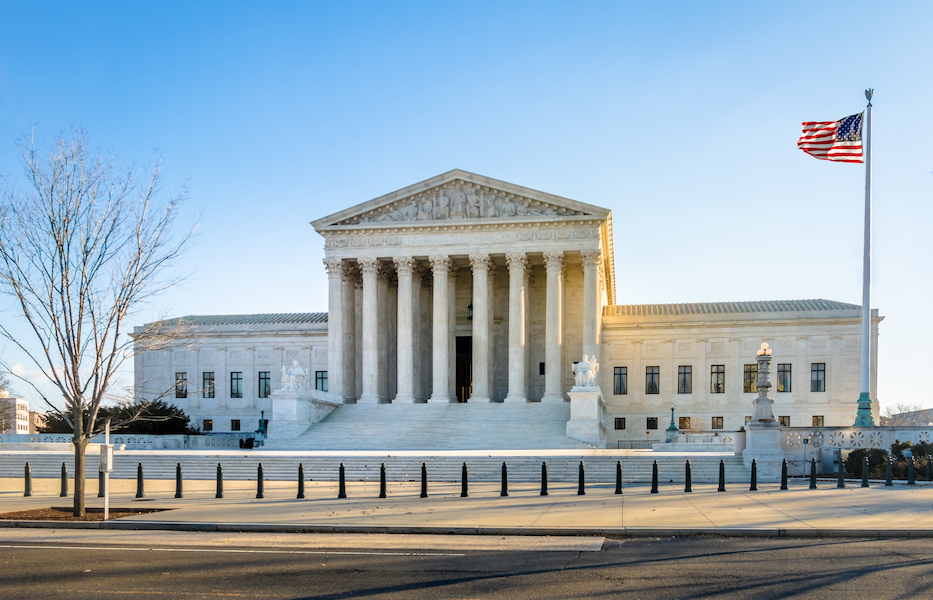SCOTUS Wraps Up Oral Arguments for the Term

The U.S. Supreme Court has concluded its oral arguments for the October 2021 Term. The justices heard arguments in six cases, which addressed issues ranging from methods of execution for death-row inmates to whether a high school football coach should be able to pray at midfield to the federal government’s controversial “remain in Mexico” immigration policy.
Below is a brief summary of the cases before the Court:
- Nance v. Ward: The case challenges Georgia’s sole statutorily authorized method of execution, lethal injection. In Bucklew v. Precythe, 139 S. Ct. 1112 (2019), the Supreme Court held that a person challenging a State’s method of execution could allege an alternative “not … authorized under current state law” and that there was therefore “little likelihood that an inmate facing a serious risk of pain will be unable to identify an available alternative.” Petitioner filed suit under 42 U.S.C. § 1983 bringing an as-applied challenge to Georgia’s sole statutorily authorized method of execution, lethal injection. Petitioner alleged the use of a firing squad as an alternative method. A divided panel held that Petitioner’s challenge could not be heard. The panel ruled that Petitioner must bring his challenge in habeas rather than via § 1983 because he had alleged an alternative method not currently authorized under Georgia law. It further held that Petitioner’s claim would be an impermissible successive petition notwithstanding that the claim would not have been ripe at the time of Petitioner’s first petition. The justices have specifically agreed to consider the following questions: “(1) Whether an inmate’s as-applied method-of-execution challenge must be raised in a habeas petition instead of through a §1983 action if the inmate pleads an alternative method of execution not currently authorized by state law; and (2) whether, if such a challenge must be raised in habeas, it constitutes a successive petition when the challenge would not have been ripe at the time of the inmate’s first habeas petition.”
- Kennedy v. Bremerton School District: Petitioner Joseph Kennedy lost his job as a football coach at a public high school because he knelt and said a quiet prayer by himself at midfield after the game ended. After considering an interlocutory petition in which Kennedy sought review of the lower courts’ refusal to grant him a preliminary injunction, four members of this Court observed that “the Ninth Circuit’s understanding of the free speech rights of public school teachers is troubling and may justify review in the future,” but concluded that this Court should stay its hand until the lower courts definitively determined the reason for Kennedy’s termination. On remand, the lower courts found that Kennedy lost his job solely because of his religious expression. Nonetheless, the Ninth Circuit ruled against him again, concluding that, even if Kennedy’s prayer was private expression protected by the Free Speech and Free Exercise Clauses, the Establishment Clause nevertheless required its suppression. The Court has agreed to decide: “(1) Whether a public-school employee who says a brief, quiet prayer by himself while at school and visible to students is engaged in government speech that lacks any First Amendment protection; and (2) whether, assuming that such religious expression is private and protected by the free speech and free exercise clauses, the establishment clause nevertheless compels public schools to prohibit it.”
- Shoop v. Twyford: The case centers on the All Writs Act and whether it may be invoked in habeas corpus proceedings. The justices agreed to consider the following questions: “(1) Whether federal courts may use the All Writs Act to order the transportation of state prisoners for reasons not enumerated in 28 U.S.C. § 2241(c); and (2) whether, before a court grants an order allowing a habeas petitioner to develop new evidence, it must determine whether the evidence could aid the petitioner in proving his entitlement to habeas relief, and whether the evidence may permissibly be considered by a habeas court.” Notably, much of the discussion during oral arguments centered on a separate issue — whether the Court has jurisdiction to hear the case.
- Biden v. Texas: This case concerns the Migrant Protection Protocols (MPP), a former policy of the Department of Homeland Security (DHS) under which certain noncitizens arriving at the southwest border were returned to Mexico during their immigration proceedings. On June 1, 2021, the Secretary of Homeland Security issued a memorandum terminating MPP. The district court vacated the Secretary’s termination decision and remanded the matter to the agency on two grounds: (1) that terminating MPP violates 8 U.S.C. 1225 because DHS lacks capacity to detain all the inadmissible noncitizens it encounters who purportedly must be detained under that provision, and (2) that the Secretary had not adequately explained his decision. The court entered a permanent injunction requiring DHS to reinstate and maintain MPP unless Congress funds sufficient detention capacity for DHS to detain all noncitizens subject to mandatory detention under Section 1225 and until the agency adequately explained a future termination. On October 29, 2021, the Secretary issued a new decision terminating MPP and providing a comprehensive explanation for the decision. The court of appeals nevertheless affirmed the injunction, endorsing the district court’s reading of Section 1225 and holding that the Secretary’s new decision could not be considered because it had no legal effect. The questions before the justices are: “(1) Whether 8 U.S.C. § 1225 requires the Department of Homeland Security to continue implementing the Migrant Protection Protocols; and (2) whether the U.S. Court of Appeals for the 5th Circuit erred by concluding that the secretary of homeland security’s new decision terminating MPP had no legal effect.”
- Oklahoma v. Castro-Huerta: The case involves the state of Oklahoma’s jurisdiction to prosecute a non-Indian defendant’s criminal neglect of an Indian child with special needs inside of the Cherokee Nation of Oklahoma’s reservation. The specific issue before the Court is: “Whether a state has authority to prosecute non-Indians who commit crimes against Indians in Indian country.”
Decisions in all of the cases are expected before the Court’s term ends next month.
Previous Articles
Key Cases to Watch During the Supreme Court’s November Sitting
by DONALD SCARINCI on November 5, 2025
The U.S. Supreme Court’s November sitting begins on November 3 and concludes on November 12, 2025...
SCOTUS Clears Way to Terminate Protected Status for Venezuelan Nationals
by DONALD SCARINCI on October 29, 2025
On October 3, 2025, the U.S. Supreme Court granted an emergency request from the Trump Administrati...
Supreme Court Cases to Watch in the October Sitting
by DONALD SCARINCI on October 23, 2025
The U.S. Supreme Court’s new term, which began on October 6, has the potential to be historic. In...
The Amendments
-
Amendment1
- Establishment ClauseFree Exercise Clause
- Freedom of Speech
- Freedoms of Press
- Freedom of Assembly, and Petitition
-
Amendment2
- The Right to Bear Arms
-
Amendment4
- Unreasonable Searches and Seizures
-
Amendment5
- Due Process
- Eminent Domain
- Rights of Criminal Defendants
Preamble to the Bill of Rights
Congress of the United States begun and held at the City of New-York, on Wednesday the fourth of March, one thousand seven hundred and eighty nine.
THE Conventions of a number of the States, having at the time of their adopting the Constitution, expressed a desire, in order to prevent misconstruction or abuse of its powers, that further declaratory and restrictive clauses should be added: And as extending the ground of public confidence in the Government, will best ensure the beneficent ends of its institution.





